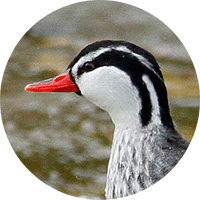Torrent Duck
Appearance: The Torrent Duck has a robust body (43 cm - 17 inches) with a large head, short neck, and a distinctive, red bill. Males have a striking appearance with a contrasting black-and-white pattern on their body. They also have bright red eyes and a prominent crest on their head. Long stiff tail. Narrown streamlined body facilitates swimming and diving with superior diving skill in turbulent water. Females are less colorful, with a more mottled brown plumage.
Habitat: Torrent Ducks are found in fast-flowing, rocky mountain streams and rivers in the Andean region. They inhabit high-altitude areas at elevations between 1000 and 3500 m. These ducks are adapted to navigate and forage in swift currents and are known for their ability to withstand turbulent, waterfall-like conditions.
Behavior: Torrent Ducks are mainly diurnal, active during the day. They are skilled swimmers and divers, capable of navigating the challenging rapids of their habitat. Their strong claws and sharp bill enable them to cling to rocks and navigate against the current. They feed by diving underwater to search for small invertebrates, aquatic insects, and plant matter.
Breeding: Breeding behaviors of the Torrent Duck occur during the rainy season, which varies depending on the region. Nesting sites are often located in rocky crevices or cavities near waterfalls or swiftly flowing streams, providing protection from predators. Females lay a clutch of about 4 to 6 eggs and are responsible for incubation, while males may guard the territory during this period.
Conservation Status: The Torrent Duck is classified as "Least Concern" by the International Union for Conservation of Nature (IUCN).
Distribution
Central Andes: The Torrent Duck is found in the central section of the Colombian Andes, including departments such as Antioquia, Caldas, Quindío, Risaralda, Tolima, and Valle del Cauca. It inhabits fast-flowing streams and rivers in the mountainous areas of these departments.
Eastern Andes: The Torrent Duck occurs in the eastern section of the Colombian Andes, which includes departments such as Boyacá, Cundinamarca, Huila, and Santander. It is known to inhabit the mountainous rivers and streams in these regions.
Taxonomy
- Kingdom: Animalia (animals)
- Phylum: Chordata (chordates)
- Class: Aves (birds)
- Order: Anseriformes
- Family: Anatidae
- Genus: Merganetta
- Species: Merganetta armata
Vocalization
Whistling Calls: The Torrent Duck produces high-pitched whistling calls that are often described as sharp and repetitive. These calls can be heard during territorial disputes or when the ducks are in flight.
Chattering Calls: Torrent Ducks also make chattering sounds, which are characterized by rapid, staccato-like bursts of vocalization. These calls are commonly heard during interactions between individuals or when the ducks are alarmed or excited.
Soft Whistles: In certain situations, the Torrent Duck may emit soft, melodic whistles. These gentle whistles are less intense compared to their other vocalizations and may be used for communication within a group or during courtship displays.
Grunts and Growls: During aggressive encounters or territorial disputes, Torrent Ducks sometimes produce low, guttural grunts or growls. These sounds are usually accompanied by physical displays, such as shaking the head or flapping the wings.
Pip Notes: Young Torrent Ducks often emit soft, high-pitched pip notes to communicate with their parents or siblings. These calls typically serve as a means of staying in contact and coordinating movements within the family group.





